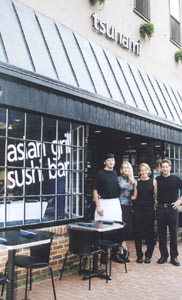 Tsunami
TsunamiThe Making of a Restaurant
 Tsunami
Tsunami
The Making of a Restaurant
West Street's New Wave
by Christopher Heagy
photo by Brittanie Oakley Riding the Storm Out: Tsunami founders Gavin Buckley, Julie Williams, Kristin Lewis and Jody Danek.
Imagine: You walk in and there is a gorgeous fish pond with beautiful plants, and you immediately realize that this is different from any place you've been to in Annapolis. You see the bar with the white tile and the stainless steel top, there are two green velvet lounge chairs to your right. A man is sitting at the window, waiting for his date to arrive. The walls are a midnight blue," expounds Tsunami co-owner Julie Williams.
Right now it's hard to imagine.
We're sitting in the dining room of Tsunami two weeks before the owners hope to open. Sheets of brown paper cover the windows. Its corners are slowly falling, letting the afternoon sun in. In the center of the room, tables and chairs are bumps beneath a large sheet.
The walls are blue, but a bench that will be covered with blue velvet still shows hard wood. The mirror is not hung.
The stainless steel bar has just been put in, but the red maple bar shelves from the previous restaurant still hang behind it. The yellow lounge chairs are nowhere near green.
Work is in progress, but there is still work to be done. There is always work to be done.
The fish pond by the door is empty.
Two couples - four friends - hope to bring Annapolis an alternative. Part sushi bar, part Pacific Rim grill, part cosmopolitan lounge, Tsunami - its owners hope - will represent each of their diverse personalities and offer Annapolis a new experience. Theirs is a small part of a larger effort to turn a revitalized West Street into a destination.
As restaurateurs, they are entering into a competitive field that sometimes turns dreams of success into nightmares of failure. But now, brought together by friendship and timing, the owners of Tsunami feel they are at the right place at the right time and ready to take off.
Julie Williams and Gavin Buckley
Gavin Buckley is a character who has fun. His life has been full of ventures and adventures. In his early 20s, Buckley and a friend came up with the concept of SunBusters. Living on the French Riviera, the pals wanted to spend more time on the beach.
The two dressed in white jump suits with, he recalls, "these George Michael tank tops - this was the '80s." They also wore large backpacks with spray guns attached; the packs were filled with suntan lotion. For a summer on the French Riviera, they sprayed tourists with suntan lotion. They were the SunBusters.
"It's still one of my favorite times," says Buckley.
Marriage to Julie Williams hasn't taken the fun out of Buckley's life. Buckley had been living in Miami when he sailed into town in 1994 and opened The Moon Cafe. Williams, originally from Annapolis, had just received her college degree from the University of Maryland.
As soon as they met, Williams and Buckley were planning to travel to New Zealand and Australia.
"Gavin is originally from Perth, Australia," Williams explains. "We decided to move to Perth and I would go to graduate school. We thought we would only be there for a couple of years while I went to school. I never went to school. We got into other things."
In Perth, Williams and a partner opened Varga Girls, a clothing boutique that sold vintage and designer wear.
Buckley opened a restaurant in Perth. Tsunami Sushi featured traditional Japanese cuisine and was a popular location.
Life in Australia was great for both Williams and Buckley.
"We had a fabulous time," remember Williams. "We had a restaurant, we did the fashion thing. It was fantastic. But I'm close with my family. Although I love Australia, I haven't lived in the United States for five years. I wanted to come home and do a little time in the States."
In the spring of 1999 the couple returned to the United States. They had planned to visit Annapolis and move on to Seattle. But once again plans changed.
West Street's New Face
Imagine: You get off work, grab your bike and head out into a beautiful fall day. You peddle from your office on West Street to your house in Murray Hill. You drop off the bike, grab a friend and head out.
Maybe you head to City Dock, check out an exhibit at Maryland Hall or grab a bite at 49 West, Tsunami or one of the other restaurants within minutes of the house. Maybe you just head out for an after-work walk through the neighborhood, greeting friends and neighbors along the way. Right now this is hard to imagine. I'm sitting in my car staring at a red sign held by a man in a bright orange vest. I'm trapped in the West Street corridor, halfway between Church Circle and Taylor Avenue. The August sun is pounding down, and the heat from the street engulfs my car. The last place I want to be is stuck on West Street.
The traffic circle at the head of West Street is almost finished. Work is in progress, but there is work to be done.
"West Street is an exciting area," says the city of Annapolis' director of economic development, Susan Zellers. "West Street is zoned for mixed use and hopefully there will be retail stores, business offices and private homes that coexist throughout the corridor. It will be a comfortable urban environment in Annapolis, one of the most desirable cities to live in."
Once the center of Annapolis' shopping and retail district, the West Street corridor fell on hard times during the 1960s and '70s. Movement to the suburbs and the strip malls that sprouted in Parole, Edgewater and Bestgate all took a toll on the merchants of West Street. As the customers left, businesses followed, leaving the city - with its overcrowding, poor parking and bad infrastructure - and heading for greener pastures.
This isn't the first time a regeneration has excited the residents of Annapolis. In 1985, the city adopted the Inner West Street Action Plan, covering Taylor Avenue to Church Circle. West Street was zoned for office, street level retail and residential development. Projects like the construction of what today is the Loews Annapolis Hotel had many believing that West Street was on the way back.
But the real estate and development market weakened in the late 1980s, and West Street continued to decay.
In 1995, talk of regeneration began anew. Then Mayor Alfred Hopkins promised to use the $1.2 million city beautification fund to build bricked sidewalks and crosswalks on West Street. Discussion of plans for a new traffic circle at Taylor Avenue and West Street began.
At the state level, the Maryland Department of Housing and Community Development designated the West Street corridor as a major revitalization area. Their Neighborhood Business Development Program offered low-cost loans to qualifying businesses and developers. The city let developers defer payments for water and sewer hook-ups, granted tax credits and unknotted the approval process for smaller projects.
All this piqued interest in West Street. But the turning point was the ground breaking on the West Street Circle.
"The West Street Circle proved that the city was going to work on the infrastructure of West Street. Developers started to jump on board," Zellers says.
Kristin Lewis and Jody Danek photo by Brittanie Oakley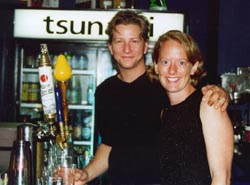
Buckley and Williams' partners Kristin Lewis and Jody Danek have made their living working in restaurants. Danek started at 19, working his way through school. At 15, Lewis started working as a busperson and salad maker at Riordan's Saloon.
Lewis and Danek spent the better part of the 1990s working at Ram's Head Tavern. With experience waiting, bartending and managing, they have been involved in every aspect of the restaurant business. The restaurant business has supported the couple and taken them around the world.
"I like the freedom that working in restaurants has given me," Danek explains. "Waiting and bartending, I have had an opportunity to travel for extended periods of time that most people just don't get. Two years ago, Kristin and I took five months off and traveled. I'm glad I had the freedom to be able to do that."
Lewis and Danek took a tour through the South Pacific, Indonesia, Southeast Asia, India, Greece, Egypt, and they were even able to visit Williams and Buckley in Australia. After returning from that trip, Lewis and Danek decided to head down a new path.
"I realized four or five years ago that I didn't want to work for anyone else," Danek says. "I'm not the type of person who is going to use my economics degree and go to work for Merrill Lynch. Waiting and bartending is difficult work. Both Kristin and I decided we wanted to do something for our future."
Back at work, the couple started planning. Over the past two years, they paid off all their debts, budgeted themselves and saved religiously. Lewis and Danek weren't sure exactly what they were saving for, but they wanted to have the capital if the opportunity to start a business arose. They'd put themselves in a position to take a risk.
"There is a financial risk. We could take a trip around the world for a lot longer than five months with this money, but we are choosing not to so that we can do this. We want to build something. There is some stress that goes along with that risk, but we can handle it. Right now we are committed to this place for a long time."
Lewis, Danek, Williams and Buckley had talked about starting a restaurant with each other before. They thought it was off in the future. They weren't planning on living in the same town. Yet it's happening.
West Street Rising
With groundbreaking on the West Street Circle, the whispers of a rejuvenated West Street exploded. Within the last year, development has taken off.
The law offices of Brassel and Baldwin moved their offices from Parole to 112 West Street in 1998. The firm took over a 9,000-square-foot office that had been empty for three years. West Street's proximity to the new county court house is making the street into something of a legal hub.
Developer Phil Dunn's 40,000-square-foot office building, built before a tenant was secured, was finished in 1998 and now near full capacity, with the Annapolis/Anne Arundel County Chamber of Commerce moving in last month.
Estimates have the office space on West Street jumping from 150,000 square feet to 450,000 square feet.
The city has purchased eight parcels of land on West Street and Colonial
Avenue and hopes to start construction of a 500- to 600-space parking garage
by year's end. Through the continued improvements to the West Street infrastructure
- new sewage and water pipes, below-ground power and telephone lines, 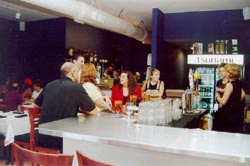 the bricking of sidewalks, the planting of trees - the traffic
circle and the new garage, city and state will commit $18 million to the
regeneration.
the bricking of sidewalks, the planting of trees - the traffic
circle and the new garage, city and state will commit $18 million to the
regeneration.
As the offices and number of workers in the West Street corridor have grown, plans for restaurant and retail stores have raced to meet the new demand. With a mix of residential and commercial buildings, the proximity to Murray Hill and President's Hill and the number of workers in the area, one of the keys to a complete regeneration of West Street is getting people to walk the streets at night, stay in the city after work and support the businesses in the corridor.
Tsunami hopes to capitalize on the buzz.
"I'd been looking around for places in Annapolis to start a restaurant for about a year," Danek recalls. "I tried to think of the flow of traffic, walking traffic, who's going to be here and where are the best places. West Street kept coming up. It's a growing area. It's an eclectic little street, and it will only get better."
photos by Brittanie Oakley A chic stainless steel bar, midnight blue walls and tightly spaced bistro tables give Tsunami's small space a powerful feel.
The Time is Right
Like almost everything, the opening of Tsunami was a matter of timing. In the spring of 1999, Buckley and Williams were leaving Australia. They toured England and spent time in Miami before returning to Annapolis in April.
Their plan was to spend some time in Annapolis before moving to Seattle in the early summer. Buckley and Williams had general plans to develop a restaurant and clothing store in Seattle, similar to the situation they had in Perth.
"We had discussed the possibility of doing something together in the past, but it seemed off in the distance because we weren't going to be living in the same town," Williams remembers.
Chance encounters sometimes change plans.
They saw a For Lease sign at 51 West Street.
"Gavin and I were riding on my scooter, and we saw that sign. I'd been looking for spots, and there hadn't been anything that had caught my eye for awhile. We saw this up for lease and I was like, 'Wow, Gavin this is it.' It felt right."
Figuring their odds were 50/50, Buckley and Williams still headed to Seattle to explore possibilities there.
In the meantime, Danek and Lewis went after the lease, with a promise from Buckley and Williams that they would return to Annapolis if the lease was signed.
In Seattle, Buckley and Williams loved what they saw, but something in Annapolis kept pulling them back.
"Gavin started saying to me, what if we stay in Annapolis?" Williams says. "We were excited about the prospect of a new project in Seattle, but there were opportunities in Annapolis that wouldn't be in Seattle. Even though we hadn't secured the lease, we came back to help make this happen."
Williams and Buckley returned from Seattle in early May. The group got the keys on May 17.
A Bumpy Road
Imagine: It's eight o'clock on a Saturday night. Every table at your restaurant is full. Customers are waiting for tables. At the bar, cocktails and witty banter flow. Even though it's busy, the kitchen is running smoothly. The food comes out looking great. The staff works in tandem and, at least for one night, everything is right in your restaurant. Everything seems right in your world.
Everyone who has ever worked in a restaurant has thought about opening their own place. Anyone who has cooked a meal or eaten out has critiqued a restaurant and thought about what they would do if they were in charge.
It looks so easy; it looks so fun. Serve food, entertain, talk to exciting people all night. It's a party every night of the week and you make money doing it. What could be better?
But no one is there when you're crunching receipts at 3am. You're all alone when your fish spoils after the refrigerator breaks, the ice machine won't make ice, a bartender drops four bottles of expensive wine, the dishwasher explodes or your cook walks out in the middle of one of your busy Saturday nights.
There is no help when an irate customer can't be satisfied. Only you and your partners come up with the next rent check and hope the pay checks don't bounce.
These are the struggles that no one sees.
There is work in progress, but there is always work to be done.
The restaurant industry is exploding, yet it is one of the most difficult markets in which to survive. Still, people keep jumping in. Seventy percent of new, independently operated restaurants go out of business within two years. Less than 10 percent of these restaurants live to see their fifth anniversary.
"The two biggest reasons restaurants fail is poor location and poor management," says Elaine Madden, an instructor in Anne Arundel County Community College's Hotel/Restaurant Management program. "People just don't know what they are getting into."
The owner at the first bar I worked at once told me, "Pay attention and you make money. The problem is most people don't know what to pay attention to."
In any restaurant, there are fixed and variable costs.
Fixed costs are rent, insurance, salaries, utilities. These are what you must have just to open the restaurant. These costs must be met every month; they don't change with the flow of business.
Food, liquor and labor costs are all variable and can be controlled with efficient management. On average, independent restaurants hope to keep food costs at 33 percent, liquor costs at 20 percent and labor at 21 percent.
This is where owners and managers have to pay attention. They can send staff home during slow times. They can make sure drinks are being paid for and beer and wine aren't walking out the door. Ordering, proper storage and preparation can keep food from spoiling, sending costs through the roof.
These are just a few of the balls the owners have to juggle. There are little things we never think of.
"When I was a manager at Middleton Tavern, I would try to look at things through the customer's eyes," recalls Ken Jarvis, instructor in the Hotel/Restaurant Management program. "I would sit down and eat a meal in a different seat every night. Then I could see the wall paper coming off the wall, the stains in the carpet, the gum under the table, the cobwebs, the stains on the servers' apron. I would look for the little details that get missed so often but are the things that turn people off."
That brings us to one of the biggest problems facing the service industry today: staff. In an economy running at full employment, it is impossible to find qualified staff and difficult to find enough bodies for a bare bones crew.
Under-employeed restaurants with under-trained staff lead to dissatisfied
customers.
"You can have the best food in the world, but if the service is bad, there is little chance at success," Jarvis says.
The owners of Tsunami know they're walking on a bumpy road. They are banking on their experience to succeed where others fail. With a smaller restaurant, they hope to keep an eye on the things that they can control and use their expertise to satisfy customers.
"When you do this sort of thing, you have to be an optimist and
a realist," Danek says. "You can't get bogged down with stress
and fear. You have to be positive and optimistic and continue to work hard
when you feel doubt about investing all this money, time and energy. To
take this step, it's all or nothing. You can't be halfway. Half way shows
in the quality."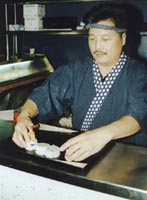
photos by Brittanie Oakley Sushi chefs don't come a dime a dozen, so finding both Stanley Hsu and Tom Hsu was a jackpot for Tsunami.
Building Tsunami
"When you have two people in an apartment, they have different opinions about how things are going to get done," explains Williams. "Now we have four people in a not much bigger space, with many different aspects, working over a short period of time. Each with strong opinions and personalities. That makes things a bit more complicated."
There was much to do between securing the lease in May and opening the restaurant in August. The group had a basic concept in their minds, but each had a vision that was a little different from the others'. They had to create a restaurant that satisfied each of them.
Licenses had to be obtained, inspections had to be passed, menus had to be created, tweaked and finished, employees had to be hired, plates, glasses, silverware, chairs and tables had to be bought and the design of the restaurant had to be reshaped.
The owners decided to do most of the light structural changes themselves. They changed the shape, painted the walls, retiled the floors and created the physical environment that they wanted. In working to open the restaurant, each owner became part painter, carpenter and handyman. It wasn't easy, physically or emotionally.
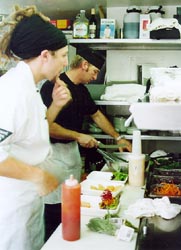 "It can get tough when there
are things you want to do and they get slowed down or don't go quite the
way you planned," Danek says. "And you have to adapt, knowing
that you're not open, you're spending money and the rent payments keep coming.
It can get stressful."
"It can get tough when there
are things you want to do and they get slowed down or don't go quite the
way you planned," Danek says. "And you have to adapt, knowing
that you're not open, you're spending money and the rent payments keep coming.
It can get stressful."
Though the process of making Tsunami a reality has been challenging and
stressful, the owners believe the last few months have built a strong foundation
for the restaurant to grow. Equally important, the owners have discovered
ways to work together.
"In some ways, it's easier for one person to make all the decisions, but mistakes can be made," Danek suggests. "We use everybody's input and experience to come up with the best solution for all of us."
Even with all the demands and stress that went along with opening Tsunami, the four owners have tried to stay focused and remember what is most important to them.
"Everybody says. 'Don't go into business with your family or friends,'" Danek tells me. "Julie and Gavin have been friends with us for a long time, and the friendship is really what's important. I'd rather work with my friends to come up with the best solution. Working with a stranger, I don't know their value structure or their style. We're going to work on this restaurant, and we're going to work on the friendship. That's what's important."
photos by Brittanie Oakley Gavin Buckley, in background, pulls his weight in the kitchen with executive chef Jonathon Jaquet, whereas Buckley's wife, Julie Williams, keeps up with the customers at the bar and in the dining room.
An Ending And a Beginning
Late in the evening on that first Friday night, the owners of Tsunami were enjoying what they had created. Most of the dinner crowd had left and a few customers remained, sipping cocktails at the bar. Danek and Buckley walked outside and smoked a cigarette. Williams was enjoying a glass of wine with her family.
Kristin Lewis sat alone in the back corner, eating sushi and looking out over the restaurant. Her face had a look of excitement, wonder, exhaustion and relief. Those years working six nights a week paid off. All the difficulties and doubts over the last three months had been met and, at least for this one night, everything felt right. The whirlwind of opening this restaurant had taken a toll, not just on her, but on all her partners.
One goal has been met, but in many ways the journey of Tsunami is just beginning. The day-to-day demands of running the restaurant are now at hand. But that was the goal.
"It's fantastic," exclaims Williams. "We've been working on this day in and day out, and it is a wonderful feeling to be open. Getting feedback from customers is spectacular. We've all been painters and carpenters. We feel some relief now that we're open. Now, we can do what we do best, entertain guests."
Four friends, two couples saw an opportunity and wanted to take a chance. Unexpectedly their paths crossed, and they went for it. Each friend had an idea of what this would be and what it will become. Working together, they have made Tsunami a reality. Working together, they hope to make Tsunami a success.
| Issue 36 |
Volume VII Number 36
September 9-15, 1999
New Bay Times
| Homepage |
| Back to Archives |